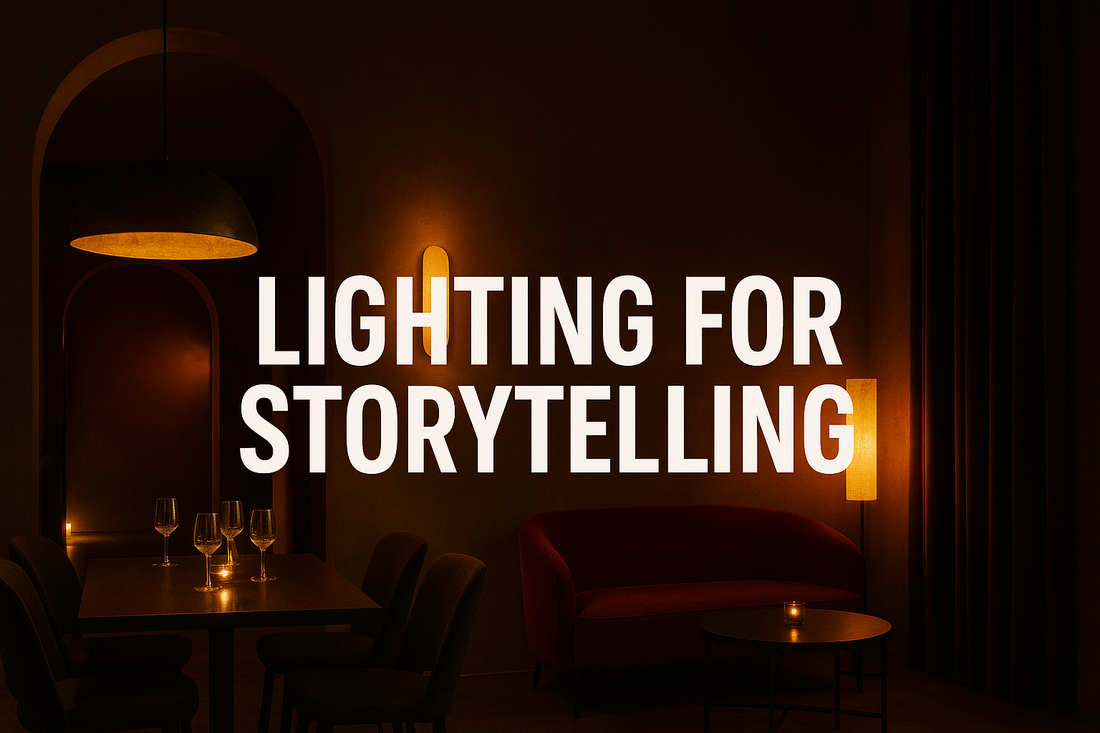
Lighting for Storytelling – How Designers Use Light to Shape Atmosphere and Experience
Share
Light does more than reveal what is already there—it speaks to us. It tells us where to go, what to notice, how to feel. Great lighting design is storytelling without words, using brightness, color, contrast, and shadow to guide the human experience.
Whether you’re stepping into a warmly lit home that whispers comfort or entering a gallery with dramatic spotlights that demand focus, lighting frames the narrative of every space.
The Role of Storytelling in Design
Every interior tells a story. Some spaces say welcome, others say focus here, and some transport us entirely. Lighting is central to that narrative.
- Emotion: Warm, dimmed lighting conveys intimacy. Bright, cool tones convey energy.
- Atmosphere: Layered lighting creates complexity, while uniform brightness flattens a room’s character.
- Journey: A well-lit path or shifting tones across a space guide people through an experience.
In storytelling, light sets the scene, builds tension, and creates resolution—just as a writer does.
Techniques of Storytelling Lighting
1. Color Psychology and Tone
- Blue tones calm and focus.
- Warm ambers comfort and relax.
-
Bold colors add drama or vibrancy.
Designers use color as emotional punctuation in a space’s story.
2. Contrast and Shadow
Shadow gives depth and intrigue. Spotlighting a sculpture against darkness creates drama; soft ambient light with gentle shadows creates calm.
3. Layering and Transitions
Using ambient, task, and accent lighting together creates flexibility. Spaces can “shift chapters” throughout the day—from work to rest, from dinner to drinks.
4. Directional Light for Focus
Where light falls, our eyes follow. Highlighting a painting, a bar counter, or a product display pulls people into the narrative.
Applications Across Spaces
Residential: Homes tell stories of comfort and personality. Storytelling lighting might include cozy lamp-lit corners, glowing staircases, or dramatic uplights on artwork.
Hospitality: Restaurants and bars rely heavily on lighting to build atmosphere. A restaurant might begin with brighter tones for lunch and transition to softer, shadowed intimacy at dinner. Hotels guide guests from grand entrances to tranquil rooms with shifts in tone and intensity.
Retail: Lighting tells the story of luxury or excitement. Soft spotlights in high-end boutiques highlight exclusivity, while vibrant, dynamic lighting in sports stores creates energy and movement.
Public Spaces: Festivals, exhibitions, and cultural events rely on immersive light to tell collective stories. Light projections, color-changing facades, and interactive installations bring narratives to life for communities.

Case Studies & Examples
Boutique Restaurant: A small restaurant used layered lighting to create a “journey” through the evening. Early hours used brighter, cooler tones for clarity; as night progressed, dimmed amber lights and candles transformed the space into a haven of intimacy.
Art Gallery: A gallery exhibition used focused spotlights on each piece, with surrounding shadow, to make every artwork feel like a discovery. The story told: This is important, pay attention.
Common Mistakes
- Overusing drama: Constant darkness or bold contrast can overwhelm.
- Ignoring function: Storytelling must balance atmosphere with practicality—people still need to see menus, read labels, or move safely.
- Uniform lighting: Flooding a space with even brightness flattens emotion, robbing it of narrative depth.
The Future of Storytelling Through Light
With digital technologies, storytelling in lighting is becoming interactive.
- Dynamic systems shift color and intensity throughout the day.
- Projection mapping transforms buildings into canvases.
- Responsive lighting reacts to motion, sound, or biometric input, letting users become part of the story.
The next decade will see storytelling lighting blur boundaries between design, technology, and performance.

Conclusion – Designing Experiences, Not Just Spaces
Lighting is more than a practical necessity. It’s an emotional tool, a storyteller, and a silent guide. Great designers know that it’s not just about what you illuminate, but also what you leave in shadow.
Whether in homes, restaurants, shops, or public spaces, lighting tells the stories that connect us to places. It transforms ordinary rooms into unforgettable experiences.
At Lighting Design Online, we specialize in lighting design that doesn’t just brighten spaces—it tells stories. Contact us today to create a lighting scheme that speaks to your vision and transforms your project into an experience.

